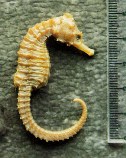| Family: |
Syngnathidae (Pipefishes and seahorses), subfamily: Syngnathinae |
| Max. size: |
14.4 cm OT (male/unsexed) |
| Environment: |
demersal; marine; depth range 0 - 10 m, amphidromous |
| Distribution: |
Indian Ocean: Red Sea, Saudi Arabia, Djibouti, and Sri Lanka. Records from South Africa, Madagascar, Mauritius and Réunion are questionable. |
| Diagnosis: |
Dorsal spines (total): 0-0; Dorsal soft rays (total): 14-17. Description: (based on 21 specimens): Adult height: 8.0-12.0cm. Rings: 11 + 34 (33-37). Snout length: 2.7 (2.4-3.0) in head length. Dorsal fin rays: 16 (14-17) covering 2+1 rings. Pectoral fin rays: 15 (14-16). Coronet: low, arch of neck a smooth curve, or slightly raised and rough. Spines: low, smooth to slightly developed. Other distinctive characters: head large compared to body; deep head. Color pattern: usually dark but can be bright yellow; specimens from Suez are pale with marbled pattern of brown lines on trunk and head. |
| Biology: |
Length type refers to height (= TL - head length). Occurs in eelgrass beds (Zostera sp.) in lagoons. Used in India for traditional medicines. Diurnal. Adults pair-bond and greet on daily basis in the laboratory (Ref. 30915). Ovoviviparous (Ref. 205). The male carries the eggs in a brood pouch which is found under the tail (Ref. 205). |
| IUCN Red List Status: |
Not Evaluated (N.E.) Ref. (130435)
|
| Threat to humans: |
harmless |
Source and more info: www.fishbase.org. For personal, classroom, and other internal use only. Not for publication.
